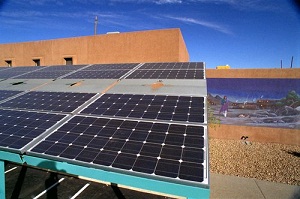Arizona’s Bullhead City Hall embraces solar
 Bullhead City Hall, in Bullhead City, Ariz., is constructing a 50 kilowatt (kW) photovoltaic (PV) array over its parking lot. The system will provide roughly 10 percent of the building’s electricity needs when completed, which is expected to happen in October. The system will cost roughly $400,000 and is being funded mostly through a partnership with the Mohave Electric Cooperative (MEC), the local utility.
Bullhead City Hall, in Bullhead City, Ariz., is constructing a 50 kilowatt (kW) photovoltaic (PV) array over its parking lot. The system will provide roughly 10 percent of the building’s electricity needs when completed, which is expected to happen in October. The system will cost roughly $400,000 and is being funded mostly through a partnership with the Mohave Electric Cooperative (MEC), the local utility.
PV carports are quickly gaining popularity as a visible way to provide PV power and refuge from the summer heat and weather as people move from their vehicles to a building.
“One of the aspects of the design was we wanted it visible and not hidden,” said Steve Johnson, Bullhead City’s public information officer, to the Mojave Daily News. “We have it where people can see it, so it stands as a model and as an example of what people can do, what businesses can do,” he said.
Bullhead City Hall is participating in MEC’s SunWatts program, which is funded through Arizona’s Renewable Energy Standard Tariff paid by Arizona’s electric customers. The program will cover two-thirds of the installation’s costs.
MEC applied for a grant on behalf of Bullhead to pay for most of the PV-carport installation. The result is that the city will have to repay only $58,000 over the next 25 years. The annual electric savings should be more than 10 percent of its total consumption.
“This project benefits our members and the community by lowering the operating costs of government, and helps demonstrate our commitment, and the city’s commitment to environmental responsibility,” said Tyler Carlson, MEC’s CEO, to the newspaper.
The city used 515,120 kW hours (kWh) over the past 12 months, the Mojave reported. In addition, the facility’s electric costs for the period amounted to $61,342.
In City Manager Toby Cotter’s 365 Days to Sustainability blog, he said, “MEC has conservatively estimated the solar system will generate on average 86,842 kWh per year. With this amount of renewable energy, the City can expect to reduce its electric expenses at City Hall by at least $7,333 in the first year; that is a reduction of 12 percent.”
Earlier this year, Cotter said in his blog that the city expected that it would take awhile to get the United States-made PV panels.
“We wish we could start sooner.” he said. “But we feel it’s worth the wait, so we can contribute to America’s economic recovery.”



